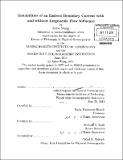| dc.contributor.advisor | Paola Malanotte-Rizzoli and Michael A. Spall. | en_US |
| dc.contributor.author | Wang, Jinbo, Ph. D. Massachusetts Institute of Technology | en_US |
| dc.contributor.other | Woods Hole Oceanographic Institution. | en_US |
| dc.date.accessioned | 2012-01-30T17:01:06Z | |
| dc.date.available | 2012-01-30T17:01:06Z | |
| dc.date.copyright | 2011 | en_US |
| dc.date.issued | 2011 | en_US |
| dc.identifier.uri | http://hdl.handle.net/1721.1/68890 | |
| dc.description | Thesis (Ph. D.)--Joint Program in Physical Oceanography (Massachusetts Institute of Technology, Dept. of Earth, Atmospheric, and Planetary Sciences; and the Woods Hole Oceanographic Institution), 2011. | en_US |
| dc.description | Cataloged from PDF version of thesis. | en_US |
| dc.description | Includes bibliographical references (p. 221-227). | en_US |
| dc.description.abstract | Eastern oceanic boundary currents are subject to hydrodynamic instability, generate small scale features that are visible in satellite images and may radiate westward into the interior, where they can be modified by the large-scale circulations. This thesis studies the stability of an eastern boundary current with and without the large-scale flow influence in an idealized framework represented by barotropic quasi-geostrophic dynamics. The linear stability analysis of a meridional current with a continuous velocity profile shows that meridional eastern and western boundary currents support a limited number of radiating modes with long meridional and zonal wavelengths and small growth rates. However, the linearly stable, long radiating modes of an eastern boundary current can become nonlinearly unstable by resonating with short trapped unstable modes. This phenomenon is clearly demonstrated in the weakly nonlinear simulations. Results suggest that linearly stable longwave modes deserve more attention when the radiating instability of a meridional boundary current is considered. A large-scale flow affects the short trapped unstable mode and long radiating mode through different mechanisms. The large-scale flow modifies the structure of the boundary current to stabilize or destabilize the unstable modes, leading to a meridionally localized maximum in the perturbation kinetic energy field. The shortwave mode is accelerated or decelerated by the meridional velocity adjustment of the large-scale flow to have an elongated or a squeezed meridional structure, which is confirmed both in a linear WKB analysis and in nonlinear simulations. The squeezed or elongated unstable mode detunes the nonlinear resonance with the longwave modes, which then become less energetic. These two modes show different meridional structures in kinetic energy field because of the different mechanisms. In spite of the model simplicity, these results can potentially explain the formation of the zonal jets observed in altimeter data, and indicate the influence of the large-scale wind-driven circulation on eastern boundary upwelling systems in the real ocean. Studies with more realistic configurations remain future challenges. | en_US |
| dc.description.statementofresponsibility | by Jinbo Wang. | en_US |
| dc.format.extent | 227 p. | en_US |
| dc.language.iso | eng | en_US |
| dc.publisher | Massachusetts Institute of Technology | en_US |
| dc.rights | M.I.T. theses are protected by
copyright. They may be viewed from this source for any purpose, but
reproduction or distribution in any format is prohibited without written
permission. See provided URL for inquiries about permission. | en_US |
| dc.rights.uri | http://dspace.mit.edu/handle/1721.1/7582 | en_US |
| dc.subject | Joint Program in Physical Oceanography. | en_US |
| dc.subject | Earth, Atmospheric, and Planetary Sciences. | en_US |
| dc.subject | Woods Hole Oceanographic Institution. | en_US |
| dc.subject.lcsh | Meridional overturning circulation | en_US |
| dc.subject.lcsh | Ocean circulation | en_US |
| dc.title | Instabilities of an eastern boundary current with and without Large-scale Flow Influence | en_US |
| dc.type | Thesis | en_US |
| dc.description.degree | Ph.D. | en_US |
| dc.contributor.department | Joint Program in Physical Oceanography | en_US |
| dc.contributor.department | Woods Hole Oceanographic Institution | en_US |
| dc.contributor.department | Massachusetts Institute of Technology. Department of Earth, Atmospheric, and Planetary Sciences | |
| dc.identifier.oclc | 773372037 | en_US |
